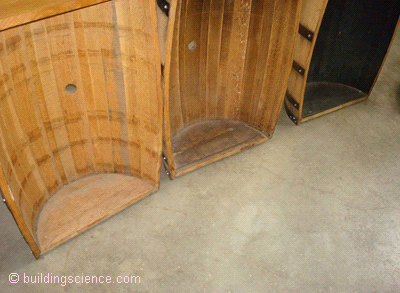Bourbon Aging Explained
Contributed by on Oct 28, 2013
Three readers love this post.
Bourbon Aging Explained
Everyone loves Bourbon because of its sweet and complex flavors. But, where do all of those flavors come from. This post will explain how Bourbon aging works and what flavors this process adds to the Bourbon. FYI, I refer to "distillate" several times in the article. This is the Bourbon after it has been distilled but before it has entered the barrel for aging. I use the word distillate since it is not Bourbon until it has been aged in new oak barrels.
Under federal standards after Bourbon is distilled it must enter in to charred new oak barrels for aging at no greater than 125 proof (62.5%). To be Straight Bourbon the Bourbon must be aged for at least 2 years. When the distillate (soon to be Bourbon) comes off of the still it is clear and only contains the flavor of the grains it was distilled from. Multiple distilleries are currently offering unaged whiskey but I would suggest saving your money. The barrel is where the Bourbon magic occurs. What happens in these barrels? How can something that taste similar to rubbing alcohol go in to charred oak barrels, sit in a warehouse for years and emerge as something so delicious? It’s magic….or science? Maybe, a mixture of the two?
Bourbon Barrels
Let’s start with the barrel or cask. Standard Bourbon barrels are 53 gallon and assembled (largely by hand) of New White Oak. The barrel does not have to be 53 gallons but generally they are. The “New” references the fact that they have not been used before. The majority of distilleries use the same barrel manufacturer, Independent Stave Company. Watch their video to see exactly how the barrels are made. It is an interesting process. It is no surprise that Bourbon gets its oak and woody flavors from these barrels. After the barrels are used for Bourbon they are usually shipped to Scotland to be used for aging by Scotch distilleries. They have also become a popular option for breweries and wineries as well. Because Bourbon uses new barrels the aging time for Scotch is usually much longer.
The Char
Each barrel is charred or toasted on the inside. There are multiple levels or charring and the level varies by distillery. A charred barrel is what gives Bourbon that slightly charred or smoky taste. It also adds sweetness with toffee and vanilla notes because the sugars in the wood caramelize during the charring process. Most distilleries use what is known as a number 4 char. Flames are shot through the barrel for 55 seconds to obtain a level 4 char. Below, we have and uncharred, medium charred and heavy charred barrels:
Distillate
Now that the barrels are ready it is time for them to be filled with the distillate. A lot of consideration goes in to this step as well. A high-alcohol concentration, such as 160 proof, extracts more of the beneficial compounds and color, but it also extracts more tannin. These tannin's are what contribute to the harsh flavor in some Bourbons. Almost all distilleries now use a barrel entry proof of between 110 and 125 proof (Buffalo Trace uses 125 for all their Bourbon whereas other Distilleries change the entry proof depending on the Bourbon). This range in proof creates a good balance of beneficial compound extraction, color and tannin's.
The Warehouse
After the distillate/bourbon is added to the barrels they are left to age and mature in bourbon warehouses or rick house. Major distilleries have multi floor warehouses with multiple rick levels where the barrels sit. Here is the amazing thing about Bourbon aging. Identical Bourbons aged for the same period of time in separate parts of the warehouse can taste drastically different. That is because of the way temperature affects the barrels. There is no temperature regulation in the warehouses so during the winter the barrels contract and then expand during the summer heat. Essentially, breathing in and out small Bourbon. Because of this, Bourbon evaporates and the distilleries experience what is known as the “Angels Share”. Angels share is the portion of Bourbon (or, any alcohol that is aged) that is lost to evaporation during the aging process.
Let’s use the 2013 release of George T. Stagg from the Buffalo Trace Antique Collection as an example. Buffalo Trace selected 157 barrels for the 2013 release. That’s 8,321 gallons of Bourbon which was reduced down to 2,218 gallons after 15 years and 11 months of aging. That is a decrease of 73.34%! Some of this loss is due to leakage but the majority of it is from evaporation That just means that all of those flavors have been reduced down to a much more concentrated liquid. Also, George T. Stagg Bourbon enters the barrel at 125 proof and exits at its bottled proof of 128.2. This difference can be even greater if the Bourbon is aged in a higher level of the warehouse.
While all steps in the Bourbon making process are important the aging process plays a huge role in the final product. Now you know how Bourbon goes from undrinkable to something that is smooth and complex.



